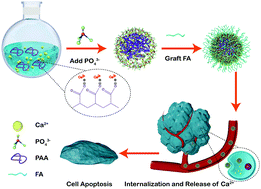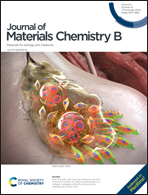A novel strategy for tumor therapy: targeted, PAA-functionalized nano-hydroxyapatite nanomedicine
Abstract
The rapid development of nanotechnology has provided new strategies for the treatment of tumors. Nano-scale hydroxyapatite (HAP), as the main component of hard tissues in humans and vertebrates, have been found to specifically inhibit tumor cells. However, achieving controllable synthesis of HAP and endowing it with cancer cell-targeting properties remain enormous challenges. To solve this problem, we developed polyacrylic acid-coordinated hydroxyapatite nanoparticles (HAP–PAA) and further chemically grafted them with folic acid (HAP–PAA-FA) for cancer treatment in this study. The nucleation sites and steric hindrance provided by the PAA greatly inhibited the agglomeration of the nanoparticles, and at the same time, the excess functional groups further modified the surface of nanoparticles to achieve targeting efficiency. The spherical, low-crystallinity HAP–PAA nanoparticles exhibited good tumor cell lethality. After grafting the nanoparticles with folic acid for molecular targeting, their cellular uptake and specific killing ability of tumor cells were further enhanced. The HAP–PAA-FA nanoparticle system exerted a regulatory effect on the tumor microenvironment and had good biological safety. All the above results indicate that this research will broaden the application of hydroxyapatite in tumor treatment.



 Please wait while we load your content...
Please wait while we load your content...